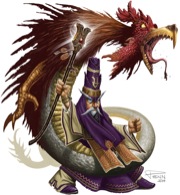Over a year ago, I went to talk to Erik about a book idea I had. The pitch was simple: "Let us do a book filled with whatever crazy ideas we have floating around in our heads". He said "no". I said, "Wait though, allow me to explain, our crazy ideas might make the game better." He said "tell me more", and Pathfinder Unchained was born.
This book is just about to be released and it is time for us to give you a good idea of the crazy ideas you will find inside. Pathfinder Unchained is a book full of rules tweaks and alternate systems you can use to mod your game, changing the way it plays. While we suspect that everyone will find their own favorite rules subsystem, just about everyone take a long look through Chapter 1, detailing alternate versions of the barbarian, monk, rogue, and summoner. So to kick off our previews, I've asked designer Mark Seifter to give you some of the juiciest tidbits about the Unchained variant classes!
Barbarian: From a game-balance perspective, the original barbarian serves her role admirably, but her mechanics are math-intensive, forcing you to recalculate numerous values once she enters rage and keep track of a bevy of once per rage abilities. Worst of all, she's the most likely character of all to die in a fight due to the way that ending rage lowers her current hit points. The unchained barbarian keeps the adrenaline-pumping fun of her former self but significantly simplifies the gameplay by adjusting the final mechanics instead of the stats themselves. For example, she gains temporary hit points instead of raising and later decreasing her current and maximum health (woo, no more dying at the end of rage!). Finally, she gains stronger versions of some of the mechanically weakest rage powers like raging climber (now you get an actual Climb speed instead of a small bonus!).
Monk: The original monk has many disparate abilities. While these abilities may be useful, they don't always synergize, and they are extremely inflexible. The unchained monk loosens up, gaining ki powers that allow you to customize your monk to fit your vision, whether it be a kung fu genius or wuxia mystic (my favorites are the ones like ki visions that let you gain divination powers that affect the narrative out of combat!). The unchained monk also has a full base attack bonus, an all-new flurry of blows, and some martial arts style strikes that help him reach his true potential (my favorite is flying kick, which lets you perform a leaping kick out to a distance equal to your extra monk movement speed once per flurry—mobile combatant for the win!).
Rogue: The original rogue has plenty of skill points and a damage increase in the form of sneak attack, but she needed a way to rule her own niche, especially with all the other classes that have things like big skill bonuses and accuracy boosts. The unchained rogue has a powerful debilitation ability that dramatically alters her ability to hit or dodge her foe, rogue's edge, which allows her to do unique things with her favorite skills (figure out surface thoughts with Sense Motive, Bluff so well you bypass truth-telling magic, use Disable Device reactively to protect yourself from a triggered trap, and much more!), and a significant boost to some of her rogue talents (For instance, minor magic? Yeah, you get that cantrip at-will). She also gets Weapon Finesse as a bonus feat and the ability to add her Dexterity to weapon damage!
Summoner: The original summoner has plenty of innovative features, but he also lacks focus and theme. As Jason was fond of describing it "You just have this amorphous blob with ten tentacles and two butts." The unchained summoner gains an eidolon that fits among existing outsiders, gaining additional abilities but also focus and theme (and if you want ten tentacles and two butts, we've still got that—go protean all the way my friend!). Some of these outsiders gain some pretty juicy abilities, like the angel's protective aura (that double strength magic circle against evil/lesser globe combo) or constant true seeing. Additionally, he possesses the spell list originally intended for the summoner.
So there you have it. We are confident that some of these classes will find a home at your game table, even if the Eidolon no longer has two butts. Tune in next week when we move on to look at some of the exciting new options in the Skills and Feats chapter!
Jason Bulmahn
Lead Designer
